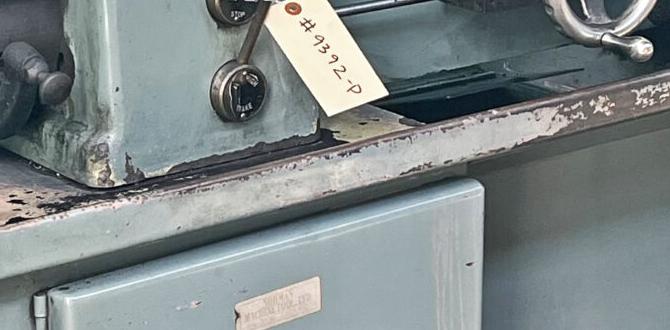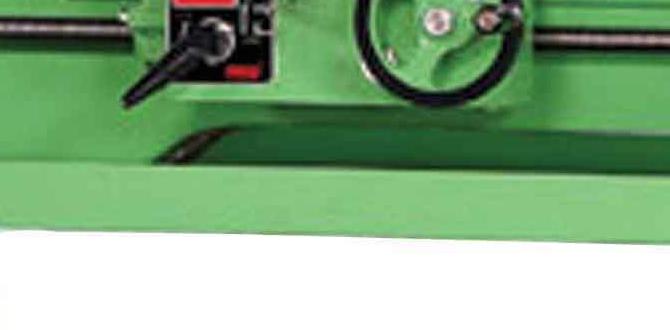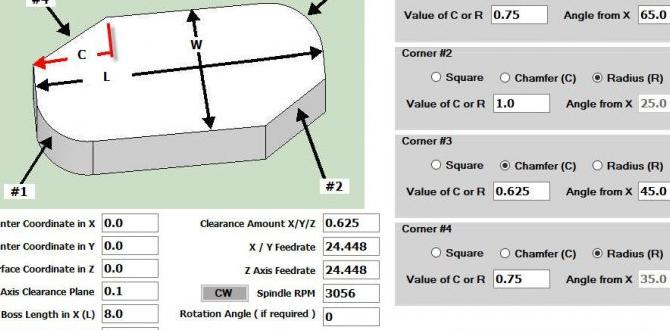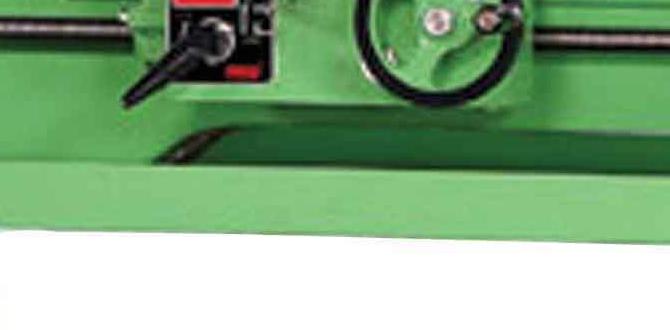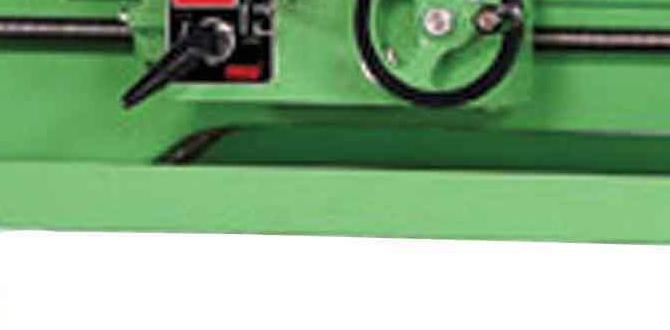Build your own DIY mini wood lathe from a grinder with this simple guide! Turn everyday tools into a functional lathe for small woodworking projects, saving money and gaining valuable skills. It’s an achievable project for any beginner.
Ever dreamed of shaping wood into beautiful forms but felt daunted by the cost of a proper lathe? Or maybe you’ve got an old angle grinder gathering dust and a hankering to build something useful. You’re in the right place! Many makers feel the same way, wishing for an affordable and accessible way to start turning wood. It’s frustrating to want to create, but feel limited by expensive tools. This guide is here to change that. We’ll walk you through building a surprisingly capable DIY mini wood lathe from an angle grinder, step-by-step. Get ready to transform your workshop and unlock your creative potential!
Why Build a DIY Mini Wood Lathe From a Grinder?
Let’s be honest, dedicated wood lathes can be pricey. For beginners or those with limited workshop space, investing hundreds or even thousands of dollars might not be feasible. That’s where the genius of DIY comes in! Repurposing an existing tool like an angle grinder into a mini wood lathe offers a fantastic solution.
Here’s why this project is so appealing:
Cost-Effective: You’re using a tool you might already own or can find affordably. This drastically cuts down on the expense compared to buying new.
Space-Saving: A mini lathe built this way is typically compact, perfect for small workshops, garages, or even a dedicated corner.
Skill Development: Building the lathe itself is a rewarding project that teaches valuable fabrication and problem-solving skills.
Functional for Small Projects: It’s ideal for turning small items like pens, small bowls, tool handles, decorative spindles, and other craft projects.
Satisfyingly DIY: There’s a unique sense of accomplishment in creating your own functional workshop tool from scratch.
Understanding the Core Concept: Angle Grinder Meets Lathe Mechanics
At its heart, a lathe needs a rotating spindle to hold the workpiece and a stationary tool rest to guide cutting tools. Our DIY mini wood lathe from a grinder cleverly uses the angle grinder’s motor and chuck for spindle rotation. We’ll then build a sturdy base and a movable tool rest.
The angle grinder provides the power and the spinning action. We need to create a stable platform to hold the grinder rigidly and a way to mount it so it spins true. Then, we’ll add a fixed or adjustable rest where you’ll hold your chisels to carve the spinning wood.
Think of it this way:
1. Motor: The grinder’s motor spins the shaft.
2. Spindle: The grinder’s chuck will become the spindle that holds your wood.
3. Bed: A sturdy frame to hold everything in place.
4. Tool Rest: A place to rest your cutting tools.
Safety First: Always Stay Aware!
Before we dive into building, let’s talk safety. Working with power tools, especially making modifications, requires utmost caution. This project involves modifying a tool not originally designed for lathe work.
Eye Protection: Always wear safety glasses or a full face shield. Wood chips and debris can fly.
Hearing Protection: Grinders and lathes can be noisy.
Dust Mask: Sawdust can be harmful to inhale.
Secure Mount: Ensure the grinder and the entire lathe assembly are rock-solid. Nothing should wobble or shift during operation.
Workpiece Security: Make sure your wood is securely mounted. Never force it.
Tool Sharpness: Sharp chisels are safer and more effective than dull ones.
Disconnect Power: Always unplug the grinder before making any adjustments or changing accessories.
Understand Limitations: This is a DIY mini lathe. It’s not designed for heavy-duty work. Overloading it can be dangerous.
Research Tool Modification: Always refer to the manufacturer’s guidelines for your specific angle grinder if possible, though modifications like this are often beyond official recommendations. Always proceed with caution and at your own risk. The U.S. Consumer Product Safety Commission offers general safety advice for power tools, which is a good starting point.
Tools and Materials You’ll Need
Gathering your supplies is the first step to a successful build. Having everything on hand makes the process much smoother.
Essential Tools:
Angle Grinder: A corded grinder is generally preferred for consistent power. Ensure it has a variable speed setting if possible – this is highly beneficial for turning.
Drill/Drill Press: For making mounting holes. A drill press offers more accuracy.
Wrenches: To tighten bolts and the grinder chuck.
Measuring Tape/Ruler: For accurate measurements.
Pencil/Marker: For marking cuts and drill points.
Saws:
Metal Saw (e.g., Bandsaw, Chop Saw, Hacksaw): For cutting metal components.
Wood Saw (e.g., Circular Saw, Miter Saw, Handsaw): For cutting the wooden base.
Screwdrivers: For assembly.
Clamps: To hold pieces securely while working.
Safety Gear: Safety glasses, hearing protection, dust mask (as mentioned above).
Key Materials:
Wood for Base: Sturdy lumber like 2x4s, 2x6s, or plywood. The thicker and heavier, the better for stability.
Metal for Grinder Mount: A thick steel plate or angle iron that can be drilled and securely bolted to your base and the grinder.
Metal for Tool Rest: Another piece of sturdy steel, angle iron, or even a thick metal drawer slide.
Fasteners: Various bolts, nuts, washers, and wood screws. Carriage bolts are good for a clean finish on the base.
Woodstock: A piece of hardwood for the actual spindle end that the wood will mount to. This will be attached to the grinder’s spindle threads. You’ll need to determine how to adapt your grinder’s spindle to accept wood. Sometimes a threaded rod and a nut can work, or a purpose-built adapter if available for your grinder model.
Bearings (Optional but Recommended): For smoother operation and better support of the Woodstock, especially if you plan to turn slightly larger pieces. Pillow block bearings are common for this.
Metal Tubing or Pipe: For the tool rest post, which will slide into a base mount.
Designing Your DIY Mini Wood Lathe
A simple design is best for beginners. We’ll aim for a robust, stable base that securely holds the grinder and allows for a functional tool rest.
Base Construction:
The base needs to be heavy and stable to prevent vibration. A simple box or a sturdy “A” frame works well.
Option 1: Box Frame: Construct a rectangular box from thick lumber or plywood. This provides ample surface area for mounting the grinder and the tool rest post.
Option 2: A-Frame: Two angled pieces connected at the top and bottom can create a stable, self-supporting structure.
We need to mount the grinder at an angle, usually around 30-45 degrees, to allow comfortable access for turning.
Grinder Mounting:
This is a critical step. The grinder must be held rigidly.
1. Template: Place the grinder head onto your chosen steel plate and mark the mounting holes.
2. Drilling: Accurately drill these holes into the steel plate.
3. Adapter Plate: You might need to create an adapter plate to match the grinder’s body to your main mounting structure.
4. Securing: Bolt the plate securely to the grinder, and then bolt the plate and grinder assembly to the lathe’s base.
Tool Rest Design:
The tool rest should be adjustable in height and angle for versatility.
Post: A length of sturdy metal pipe or tubing can serve as the post. This post will slide into a socket mounted on the base.
Rest Surface: A flat piece of metal (steel or aluminum) is attached to the top of the post. You can bend it to create a curved surface to better support your tools.
Adjustment Mechanism: To adjust height, you can drill multiple holes in the post and secure it with a bolt. For angle, a simple pivot with a bolt can work, or you can rely on friction with a tightening knob.
Spindle Considerations:
How will the wood attach to the grinder spindle? This is where creativity meets practicality.
Direct Threading: If your grinder has exposed threads, you might be able to buy a matching nut and a piece of threaded rod. The Woodstock can be threaded onto this.
Faceplate Adapter: Some grinders have a spindle that can accept a small faceplate or flange. You can then fix your Woodstock to this.
Drilled Spindle: For some grinder models, the spindle itself might be drilled or have a center hole that can be tapped and used to attach an adapter.
Important Note: Always ensure any adapter you create is balanced. An unbalanced spindle will cause severe vibration and is dangerous. Research adapters specifically for your grinder model if possible. Ensure the Woodstock piece is centered and securely fastened to the grinding spindle.
Step-by-Step Build Guide
Let’s get hands-on! This guide breaks down the construction into manageable steps.
Step 1: Prepare the Base Structure
1. Cut Lumber: Based on your chosen design (box or A-frame), cut the wood pieces to size. Ensure all cuts are square for a strong assembly.
2. Assemble Frame: Use wood screws and potentially wood glue to assemble the frame. For a box frame, build four sides and then attach a top and/or bottom for rigidity. If using plywood, cut large panels and assemble them into a sturdy box.
3. Add Reinforcement: Consider adding diagonal braces or thicker sections where the grinder and tool rest will be mounted to prevent flexing. We need a very rigid structure.
Step 2: Create the Grinder Mount
1. Select Metal Mount: Choose a piece of thick steel plate or angle iron. Its size should be sufficient to span across the grinder’s body where it can be firmly clamped or bolted.
2. Mark and Drill: Carefully position your grinder onto the metal mount. Mark the locations of the grinder’s body mounting points (if any unused ones exist) or where you can safely clamp the grinder. Drill the corresponding holes in the metal mount.
3. Test Fit: Bolt the metal mount to the grinder. It should be snug and not slip. If your grinder has a side handle mount, you might be able to adapt that.
4. Prepare Base Mounting Points: On your wooden base, decide where the grinder assembly will sit. Mark and drill holes through the base for bolts that will secure the metal mount.
Step 3: Design and Build the Tool Rest
1. Tool Rest Post Socket: Cut a length of metal tubing or pipe. This will be the socket for your tool rest post. Securely attach this socket to the base, ensuring it’s perpendicular to the base surface and positioned opposite the grinder. You can do this by drilling holes through the base and bolting the socket, or by creating a solid wooden block with a hole drilled to snugly fit the tubing.
2. Tool Rest Surface: Take your flat metal piece. You can bend it slightly to create a gentle curve. This is where your chisels will glide.
3. Connecting Post and Rest: Weld, bolt, or use strong brackets to attach the metal rest surface to the top of your tool rest post (the pipe you’re holding).
4. Adjustment Mechanism:
Height: Drill a series of holes down the length of the socket on the base. Attach a bolt with a wingnut or knob to your tool rest post, which will pass through the selected hole to set the height.
Angle (Optional): You can create a pivot at the top of the socket for angle adjustment, or simply rely on friction.
Step 4: Mount the Grinder and Create the Spindle Adapter
1. Secure Grinder to Mount: Bolt the grinder firmly to the metal mount plate you prepared earlier. Ensure it’s tight and doesn’t wiggle.
2. Mount Grinder Assembly to Base: Position the grinder assembly onto the base. Mark the holes and drill through the base. Use sturdy bolts with washers and nuts (preferably locking nuts or use thread locker) to secure the metal mount and grinder to the base. Ensure the grinder is at the desired angle (e.g., 30-45 degrees).
3. Spindle Adaptation (Crucial Part!):
Identify Threads: Look at your grinder’s spindle. What size threads does it have? You can often find this information in the grinder’s manual or by measuring.
Obtain Adapter Parts: You’ll likely need a nut that matches your spindle threads and a piece of threaded rod.
Prepare Woodstock: This is the part that holds your wood. It needs to be securely attached to the threaded rod. A simple way is to drill a hole into a block of hardwood (your Woodstock) that’s slightly smaller than the rod, then thread the rod in tightly. You can then use epoxy or even lock nuts to further secure it. Or, if your spindle threads are suitable for direct mounting, you might attach the Woodstock directly.
Assemble Spindle Adapter: Screw the nut onto your grinder’s spindle. Then thread the rod (with Woodstock attached) onto the spindle, securing it against the nut. If you have a faceplate or similar, you can mount the Woodstock to that instead.
Balance Check: Spin the grinder’s motor by hand with the spindle adapter attached. Does it feel balanced? Any significant wobble needs to be addressed. This is critical for safety and performance. You may need to shim or re-center your Woodstock.
Step 5: Initial Testing and Refinements
1. Grounding Check: Ensure your grinder is properly grounded if it’s a 3-prong plug.
2. Tool Rest Placement: Position the tool rest close to the spindle end, leaving just enough space for the wood.
3. Power On (Very Carefully!): With no wood attached, turn the grinder on at its lowest speed (if variable). Listen for unusual noises. Check for excessive vibration. If anything seems off, power down immediately and re-check all mounts and connections.
4. Speed Control (If Applicable): If your grinder has variable speed, experiment to find suitable speeds for different tasks. Lower speeds are safer for beginners and for larger diameter wood.
5. Secure Everything: Double-check every bolt, screw, and connection. Ensure the base is stable and does not move.
Using Your DIY Mini Wood Lathe
Now for the fun part! Turning wood on your newly built lathe. Remember, safety is paramount.
Mounting Your Wood:
1. Prepare Wood: Your wood needs to be mounted securely. You can:
Screw Faceplate: Screw a DIY faceplate (a piece of plywood or MDF securely attached to your wood) onto the Woodstock.
Drill and Bolt: For longer pieces, you might drill a hole through the wood and bolt it to the Woodstock.
Glue: For small turnings, you might glue a sacrificial wood block to the Woodstock and then glue your workpiece to that.
2. Ensure Balance: Try to center the wood as much as possible to minimize vibration.
The Turning Process:
1. Position Tool Rest: Adjust the tool rest so it’s close to the workpiece (about 1/8 inch or 3mm gap) and at a height that supports your chisel roughly at the center line of the wood.
2. Chisel Angle: Hold your woodturning chisel with the bevel down. Rest the tool shank on the tool rest. The cutting edge should be presented to the spinning wood at a slight angle.
3. Gentle Cuts: Apply light pressure. Let the tool do the work. Don’t try to remove too much material at once.
4. Move Slowly: Gradually shape the wood, moving your tool along the length of the workpiece as needed. You’re aiming to create a cylinder first, then you can taper, create coves, beads, or bowl shapes if your workpiece size allows.
5. Check for Wobble/Vibration: If vibration increases significantly, stop the lathe and check your workpiece mounting and the grinder’s stability.
6. Sanding: Once shaped, you can often do light sanding while the lathe is running at a low speed, or by hand.
Speed Considerations:
Tiny Project/Hardwood: Higher RPMs might be suitable.
Larger Project/Softwood: Lower RPMs are safer and provide more control.
Comparison: DIY Grinder Lathe vs. Commercial Mini Lathes
| Feature | DIY Mini Wood Lathe From Grinder | Commercial Mini Wood Lathe |
| :———————- | :————————————————————– | :————————————————————- |
| Cost | Very Low (uses existing or cheap grinder) | Moderate to High (can be several hundred dollars) |
| Build Time | Moderate (depends on complexity and skill) | None (ready to use out of the box) |
| Power/Torque | Varies greatly by grinder; can be less than dedicated motor | Designed for turning; consistent power and torque |
| Speed Control | Dependent on grinder; variable speed is a key advantage | Often variable speed controlled by electronics |
| Stability/Vibration | Can be excellent with a heavy base, but prone to more vibration | Engineered for minimal vibration; very stable |
| Feature Set | Basic; tool rest adjustment is key | Often includes tailstock, faceplate, tool rest variations |
| Durability | Depends entirely on build quality; maintenance crucial | Generally engineered for long-


